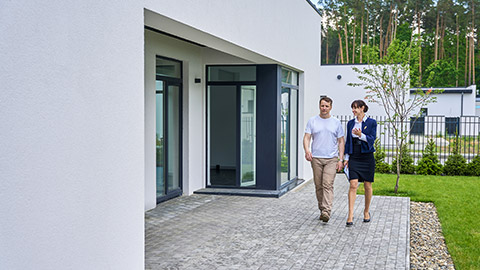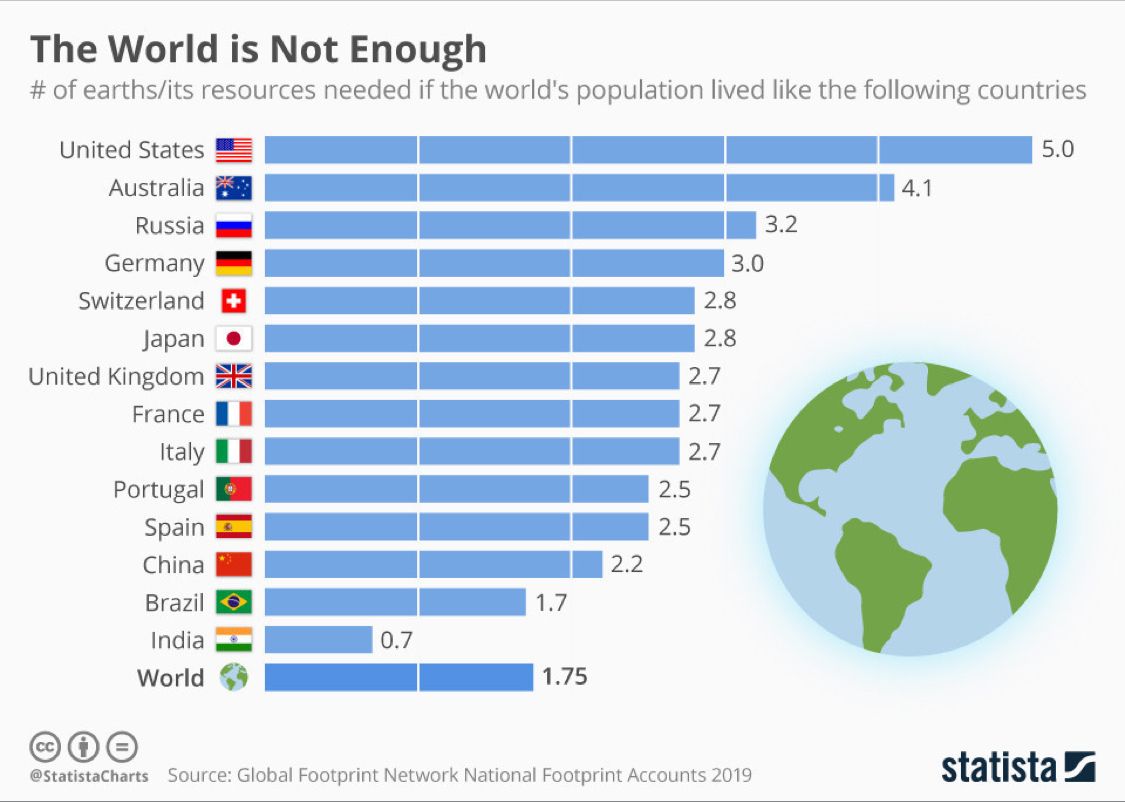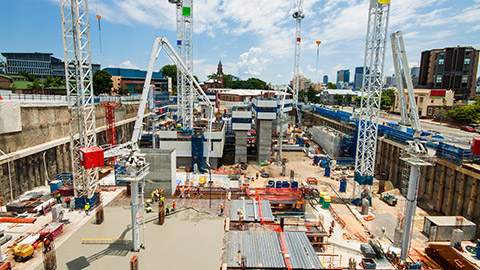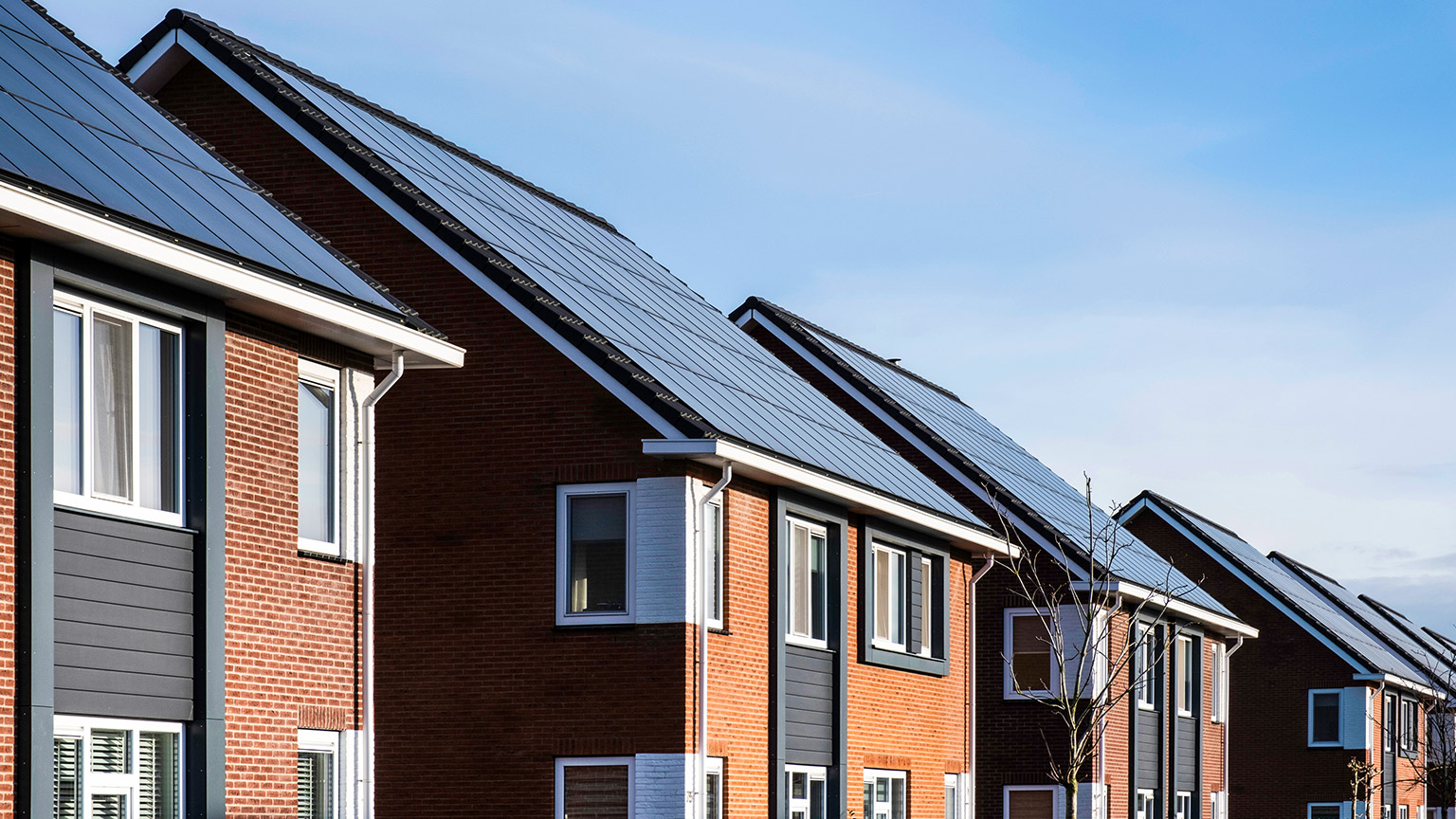Welcome to Responsibilities and Accountability.
This is the first topic of our Sustainable Practice module.
The learning outcome of this module is to identify current government and council environmental principles supporting sustainability on the construction site, interpret the sustainable guidelines and apply them to programming for construction work and recognise environmental awareness and consider the potential impact of the construction industry on the environment.
Module 11 Introduction from Will
Click ‘Video Transcript’ or the plus icon (+) to expand and reveal the transcript for the previous video.
Welcome to this module on Sustainable Practices. The learning outcome of this module is to apply knowledge of social, economic and environmentally sustainable worksite practices in a construction work programme. Nowadays, the construction industry is feeling the heat to go green. It's not just about making money; it's about doing what's right for people and the planet.
Sustainable construction means building in ways that don't harm the environment, treat everyone fairly, and make economic sense in the long run. We're here to talk about how these green practices can make a big difference in our world. Let's explore the exciting world of sustainable construction together!

We know already that the buildings and the construction infrastructure provide essential benefits such as employment, education, and health. But they also come at a cost, contributing substantially to greenhouse gas emissions and other environmental, social, and economic issues that are frequently overlooked.
As a leader on a project, the tone you set — showing regard for your environment and the principles of sustainability — from project planning through build and completion make a crucial difference in meeting your project's sustainability goals.
The New Zealand government is the primary source of motivation, standards, and best practices in this field.
Ministry for the Environment — Manatū Mō Te Taiao (Sustainability Strategy July 2022 –June 2025-PDFSustainability for us at the Ministry for the Environment means operating within our baseline, minimising our environmental impact, and providing our people with what they need to flourish.
You probably noticed that environmental awareness has surged over the past few years and the construction industry is now starting to seriously consider its environmental footprint, particularly in the last 10 years.
However, concrete actions and practices to alleviate the impacts of the construction industry are becoming more recent, and genuine consideration of environmental, economic, and social aspects of sustainability together are still rarely being achieved on-site. This is often referred to as the pillars or the triple bottom line, which we'll cover in a bit more detail shortly.
As with any subject changing this quickly, sustainable construction has seen a proliferation of ideas and terminology, sometimes leading to confusion due to the multiple ways of describing the same techniques, technologies, and processes.
Impact bigger than you might think
Media and political coverage often highlight the environmental impact and effects of activities like increased car use and aviation, which with its growing rate, is significantly contributing to greenhouse gas emissions. However, the built environment and construction industry actually have a larger overall impact, despite its less obvious nature.
A unified approach is needed

We lack a unified approach to sustainability solutions. The growing urgency to address environmental concerns has spurred the development of various solutions, including management systems, design innovations, technological advancements, and changes in work practices.
Nevertheless, at the moment there is no commonly agreed approach to addressing sustainability in construction NZ.
Over the next four topics, we'll look at the issues our industry faces, who has the accountability and responsibility to change behaviours, and offers a wide range of possible solutions. We don't endorse or recommend any particular methodology or practice, instead, we want to provide you a basis for making your own informed decisions on how to make your project's building-related activities more sustainable in its approach as the industry's regulations and legislation provide oversight and compliance.
Responsibility and Accountability

Why bother with sustainability?
The responsibility and accountability for sustainable construction falls to everyone involved in the industry — from governmental officials establishing environmental protection regulations to company owners, site project managers, and consumers making purchasing choices, everyone has a part to play.
In this module, we will concentrate on the environmental practices of the commercial construction industry, outlining their responsibilities and how they can be held accountable for them.
Apart from the clear environmental benefits and regulatory compliance of adopting sustainable practices, which we have discussed earlier, there are numerous other compelling reasons why a modern construction company should take action as part of overall efforts to improve their site practices.
Some of these are:
- Market Demand and Social Responsibility
- Reputation and company branding
- Future-proofing quality
Market Demand and Social Responsibility
There is a growing demand for sustainable buildings and infrastructure among buyers, consumers, businesses, and local councils. Adopting sustainable practices can help individual construction companies meet growing social demands and stay competitive in the marketplace. The social obligation goes beyond the project's responsibility to obey rules and regulations. It means a company’s sustainable decisions shouldn’t be based solely on financial factors. They should also take into account the local environmental considerations.
Reputation and company branding
Recently increase in public awareness of environmental and sustainable development issues, largely caused by an explosion in media coverage, has brought much wider. Interest on the subject so that your company demonstrates a commitment to sustainability can enhance your company's reputation and brand image. It can attract environmentally conscious clients as well as employees while making a difference in your approach from that of your competitors.
Future-proofing quality
Sustainable practices can help future-proof a construction project by ensuring its resilience to climate change and other environmental challenges. This can increase the longevity and value of the project over time. Although there are usually costs involved in compliance with new regulations, the costs of not complying with these standards are generally much greater in the long run, therefor it is within a company’s interests to adapt its processes and practices as early as possible.
Our one planet

Studying the information above, we can see that if everyone in the world lived and used their natural resources as they do in Australia, we would need more than four more planets to support our only earth!
According to this chart, Australia consumes resources much faster than the planet can replenish them by a factor of four.
Sustainable living involves living within the earth’s capacity and this has been developed into the idea of ‘One Planet Living’, an initiative created by WWF (World Wildlife Foundation) and Bioregional.
The One Planet Living initiative provides a vision and a set of guiding principles for a more sustainable world. New Zealanders, despite our 100% PURE tagline, would need at least two planets to continue to live the way we do.
We've provided a video about this below, but here's the shorthand:
One Planet Living is based on ten guiding principles that provide a framework for organisations and individuals to identify, plan, deliver and communicate sustainable development initiatives. The aim is to make it easy, attractive and affordable for organisations to think and act sustainably, focusing on green buildings, infrastructure, products and services.
Explore
Watch: What is One Planet Living? (5:08 minutes)
Watch this video if you are inspired to learn more about the "communities, companies, towns, and cities worldwide that have been using Bioregional's One Planet Living framework to create action plans to make truly sustainable living a reality."
It's also called Sustainable Development, but what is it?
To answer this question, watch the following video.
Explore
Watch: "What is sustainable development" (3:40 minutes).
After watching, complete the two activities below to help ensure you understand the main points.
This three-question quiz will check your answers immediately and progress automatically.
A growing and urgent need

We face a growing and urgent need for sustainability in the way we design and construct buildings.
Rapid population growth, economic progress, and the resulting rise in resource demand are exerting significant pressure on our planet. Advances since the Industrial Revolution have brought about great scientific understanding and industrial benefits. However, they have also led to increased pollution and accelerated environmental degradation.
The relationships between people, land management, resource utilisation, and the environment are interconnected and influence each other. Construction activity as a whole is vital for development. Still, with this increase, we must be carefully planning to address future needs for our children’s children without worsening existing issues in land and resource management.
The New Zealand government is leading the charge to help the industry by providing legislation and standards. There has been a sharp rise in policy and regulations related to sustainable construction practices, the improvement of related materials, and the development of different management strategies and equipment methods.
Branz NZ on Sustainable ConstructionBuilding sustainably is about using practices and systems that lessen impact on the environment, lower running costs and make homes healthy, accessible and comfortable. It includes energy efficiency, the move to a net zero-carbon economy and building resilience against hazards such as earthquakes, storms and flooding.
Some key aspects of sustainable construction include:
Regardless of the version of sustainable practices you read, there will be significant implications going forward for the building industry. The building sector, along with the material industries that back up these projects, is one of the main consumers of natural resources worldwide and plays a significant role in the current unsustainable development path of the global economy.
further Reading
To learn more about how other countries are using up their natural resources, read this article from the “World Economic Forum”, The world's economy is only 9% circular. We must be bolder about saving resources.

It begins with kaitiakitanga
Kaitiakitanga means guardianship and protection. It’s a way of managing the environment, based on the Māori worldview that recognises our interconnectedness with the land and nature.
It is important to remember that the subject of sustainability practices in construction covers a lot more than just environmental factors — it also covers economic and social aspects, which are sometimes overlooked.
Media and television coverage tends to always concentrate on the negative environmental impacts of global development as it reflects the rapid progress in scientific research and rising public interest on the subject of climate change. However, as in New Zealand and the rest of the world, a healthy and stable economy is vital to combating the need to resolve environmental problems. In any case for future generations, sustainable options and practices will offer greater value for money over their lifetime.
So, in addition to the financial benefit of protecting the environment, having sustainable options provides significant social benefits too, such as enhanced wellbeing, crime reduction, and community cohesion. Having a positive, sustainable building environment potentially boosts employee productivity and accelerates all worker's wellbeing, which, in turn, has an economic benefit as well.
These considerations (as shown below) are often referred to as the three pillars of sustainability or the triple bottom line. Each pillar represents a set of responsibilities and good sustainability practices happen in the space where all three pillars meet.
- Environmental
- Social
- Economic
The diagram below shows how they are linked together. It demonstrates that sustainable development cannot be achieved without considering all three factors.
Explore
Watch: Two minutes to understand sustainable development (3:50 minutes)
The video provides a good summary of sustainable pillars. After watching, you should see that together these three pillars form the foundation of sustainability. Each pillar represents a critical aspect that must be addressed to achieve a sustainable future.
Employee's wellbeing
Engaged employees are more likely to embrace sustainable practices. How an employer relates to employees plays a vital role in sustainable worksite practices. You have likely had one or both of those roles at this point in your life.
Take a moment and consider how you think employers can build strong relations with workers, then select the label or (+) sign below to compare your list to ours for more ideas.
- Employers can involve employees in decision-making processes related to sustainability, creating a sense of ownership and responsibility.
- Employees can be offered incentives and recognition for applying sustainable practices that align with the company's goals.
- Leadership can and should prioritise employee health and wellbeing.
- Information about sustainability goals needs to be communicated transparently to all employees.
- The company can develop a culture of continuous improvement in sustainability.
Interconnectedness of the pillars
In addition to the main pillars you will see in the picture above the video, there is a cross-over in the context, attainable, equitable, and bearable. These are often used to describe additional dimensions or principles that complement the three pillars (economic, social, and environmental sustainability).
These principles are sometimes referred to as “interconnectedness”.
- Attainable (Economic Sustainability): also called viable. This principle emphasises the need for economic systems to be attainable or feasible over the long term. It helps to ensure economic activities are economically viable and can be sustained without depleting resources or causing severe economic disruptions.
- Equitable (Social Sustainability): Social sustainability is considered equitable when it ensures that all members of society have access to resources and opportunities that allow them to lead fulfilling lives. It involves promoting social justice, inclusivity, and equal access to essential services and opportunities.
- Bearable (Environmental Sustainability): This principle emphasises the need for human activities to be bearable or sustainable within the limits of the natural environment. It involves ensuring that human activities do not exceed the earth's capacity to regenerate resources, absorb waste, and maintain ecological balance.
The fourth pillar

Detail of the entrance gate to the Waitangi Regional Park, New Zealand.
Overseas it is more common to work with the three pillars of sustainability or the triple bottom line and consider cultural impacts as part of social sustainability. But given New Zealand’s rich cultural history, with Māori tradition and beliefs at its backbone, New Zealanders need to work with the quadruple bottom line or the fourth pillar and consider this pillar of sustainability separately.
Applying the cultural pillar
As we already know, cultures vary greatly across communities, making it challenging to create a nationally standardised approach or practices. To incorporate this pillar, spend time finding out about the cultural practices of the community around your project's location and see how you can use this pillar to promote sustainable development planning. Also having more understanding of the customs of the local iwi will help sustain good relationships with some of your team members.
Some cultures have already developed systems and legislation to ensure that this cultural pillar is considered during decision-making and policy-making.

The Hawaii Environmental Policy Act (HEPA) was enacted to “establish a system of environmental review which will ensure that environmental concerns are given appropriate consideration in decision making along with the economic and technical considerations”. This Act applies the quadruple bottom line stance. This leads to a more rounded assessment, in which the environmental, economic, social, and cultural effects caused by a proposed action are all considered before a decision is made.
Further Reading
Read more: How Hawaiians are using traditional practices to promote sustainability on LonelyPlanet.com.
Feeling inspired? Let's check your knowledge.
Use these activities to consolidate your learning about sustainable development by following the guidance of the four pillars.
Activity 1: Drag the words
Activity 2: This incomplete table shows resource consumption patterns and their effect levels of sustainability. Drag the corresponding term into the correct letter to match the empty blanks to the state of the environment and its sustainability factor.
| Consumption of resources | State of the environment | Sustainability |
|---|---|---|
| More than nature’s ability to restock | Damaging | A |
| Equal to nature’s ability to restock | B | C |
| Less than nature’s ability to restock | Unstable | Sustainable development |
We threw a new term into this activity, steady-state sustainability. Check out the definition if you want to learn more. For more terms, here is a useful glossary from the Sustainable Business Network.
Activity 3: Connect the pillars to sustainable construction
Great work! You can now move onto the next topic.
